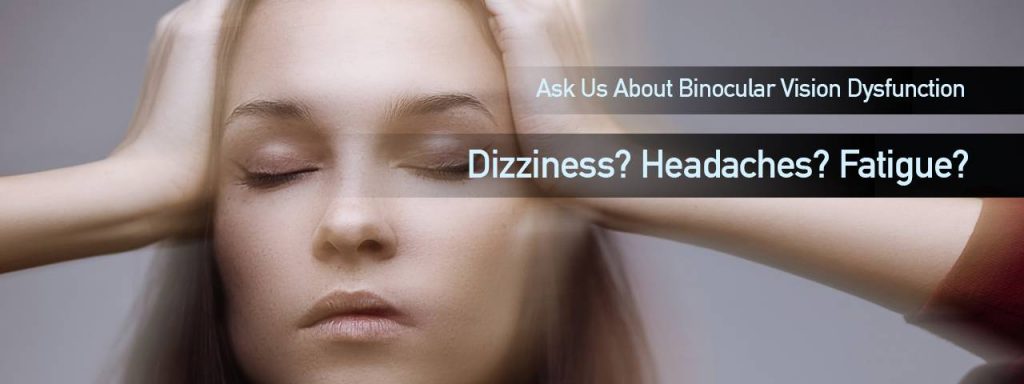Do you feel dizzy? Do you have frequent headaches? Do you experience motion or sea sickness?
You may be suffering from vertical heterophoria.
What is vertical heterophoria (VH)?
Vertical heterophoria (VH) is a type of binocular vision dysfunction (BVD) resulting from a vertical misalignment of the eyes.
Vertical heterophoria occurs when one eye is slightly misaligned, resulting in serious vision problems.
Even slight misalignment between the two eyes causes there to be a significant enough difference in the visual information sent to the brain by each eye, that your eye muscles are forced to make constant corrections to help you see clearly.
Over time, this constant strain on the eye muscles leads to a number of uncomfortable symptoms, including eye strain, headaches and even migraines.
Causes of vertical heterophoria
In the vast majority of cases, vertical heterophoria is a condition that a person is born with, as its primary cause is your DNA genetics.
Because our bodies and brains are remarkably good at compensating for shortcomings and disabilities, it may take years for the effects of vertical heterophoria to surface, and for symptoms to become apparent.
In some cases, a traumatic brain injury, such as a concussion can bring on or exacerbate symptoms of vertical heterophoria.
Symptoms of vertical heterophoria
Vertical heterophoria symptoms are often not constant. You may go hours or even days without feeling any symptoms at all, before sudden onset leaves you feeling disoriented and sick.
Symptoms may include:
- Dizziness
- Headaches ranging in intensity, from minor discomfort behind the eyes to pounding at the temples.
- Migraines
- Pressure or a feeling of heaviness in the crown of the head, comparable to sinus pain.
- Feeling unsteady when walking or inability to walk straight
- Nausea
- Motion or sea sickness
- Pain when moving the eyes
- Sensory overload; disorientation due to an excess of visual stimuli
- Driving difficulties
SEE RELATED: What is Binocular Visual Dysfunction (BVD)
If you are experiencing any of the symptoms above, schedule an appointment with an eye doctor near you, you may have vertical heterophoria.
Does vertical heterophoria impact driving?
Binocular vision dysfunction, including VH, can sometimes make people feel anxious when driving, because their peripheral vision tricks them into feeling as though objects that are stationary are actually in movement.
Some people also report dizziness while driving, making them feel like the car is rolling backward, even though they know their foot is on the brake.
In many cases, driving difficulties are brought on by very specific actions, such as:
- Rapid side-to-side head movements
- Noticing other cars zip by in your peripheral vision as you drive
- Rounding curves while driving or in the passenger seat of a car
- Standing or straightening up quickly after sitting, squatting or bending
Can vertical heterophoria be misdiagnosed?
It is quite common for VH to be misdiagnosed as a disorder of the inner ear, migraine issues, multiple sclerosis or vertigo. This is because VH symptoms often imitate the symptoms of these disorders, and are not problems that are naturally associated with a vision condition.
Only an optometrist specially trained in the diagnosis and treatment of binocular disorders can diagnose and treat VH.
Allergies and issues associated with poor sleep habits are also routine misdiagnoses.
Standard vision screenings are insufficient for diagnosis of VH, as they only check for 20/20 vision. A person with VH may have perfect 20/20 vision, while still suffering all the ill effects of this disorder.
How is vertical heterophoria treated?
Treatment of VH involves correction of the misalignment. There are a few ways your eye doctor may go about helping with this.
Therapeutic prism glasses may help reduce or eliminate symptoms such as headache, dizziness or eye strain. However, for prism glasses to be effective, they need to be worn most of the time and symptoms can be expected to return if the prism glasses are removed.
A more permanent solution for VH is vision therapy.
Vision therapy is a doctor-prescribed eye training regimen that involves both in-office and at-home exercises meant to strengthen the connection and coordination of the brain with the eyes.
LEARN MORE: Guide to Binocular Visual Dysfunction (BVD)
For more information on how vertical heterophoria is diagnosed and treated, contact your local eye doctor.
Do you feel dizzy? Do you have frequent headaches or migraines? Do you experience motion or sea sickness?
You may be suffering from vertical heterophoria.








